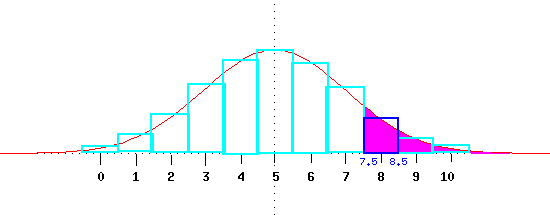Hi everyone! Read through the material below, watch the videos, work on the laboratories and follow up with your instructor if you have questions.

Header text
Header text
Topic: Binomial Distribution
The binomial distribution describes the probability of having exactly
WeBWorK. Set 4.3
Learning Outcomes
- Determine if a random variable
- The trials are independent.
- The number of trials,
- Each trial outcome can be classified as a success or failure.
- The probability of a success,
- Calculate the number of possible scenarios for obtaining
- Calculate probability of a given number of successes in a given number of trials using the binomial distribution:
- Calculate the expected number of successes in a given number of binomial trials
Common Resources
- Openstax Introductory Statistics:
- Open Intro Slides
Videos
Example
Suppose the chance of getting a head by flipping a bent coin is
Answer
We can have the head occur in any of the 4 trials: httt, thtt, ttht, ttth. This corresponds to the binomial coefficient
The general theory
Header text
Header text
Header text
Header text
In general, if the probability of a success for a single trial is
Four Conditions to check for binomial:
- The trials are independent.
- The number of trials,
- Each trial outcome can be classified as a success or failure.
- The probability of a success
Header text
Header text
Taking it one step further
Normal Approximation of the Binomial Distribution
Let
Rule of thumb: the binomial distribution with probability of success
More specifically, using the parameters
- mean:
- standard deviation:
then the following approximations hold:
The 0.5 is known as a continuity correction .

Example: if
As you can see, the approximation may be very rough, even if the “rule of thumb” conditions are met.
Galton Board with different sized balls
- Thyago: Doesn’t the fact that some balls are hitting each other interfere with the independence assumption? I mean, the probability of going right or left is biased by the interactions between the balls.
- Chris Beck: Lack of independence seems to be causing the drift from the normal distribution. The large balls are processed relatively independently as only 1 can fit through each condition at a time.
- David Bulger: Watching the small balls fall, you can see that they tend to gather momentum and run in diagonal paths to the left or right—that is, they don’t change direction much. This illustrates the importance of the independence assumption in the central limit theorem: if the individual random variables are not independent, then their sum may not tend to a normal distribution.
Why do YOU think the results are so different depending on the size of the balls?
Excel-based Course Resources
- The proprietary texts:
- Introductory Statistics by Sheldon Ross, 3rd edition: Section 5.5
- Statistics with Microsoft Excel by Beverly J. Dretzke, 5th ed., BINOMDIST(s,n,p,false) P. 104 – 108
- Slides
- Classwork
- Excel Lecture
Videos
R-based Course Resources
- Slides
- Classwork
- R-laboratory
Videos
The Applied View
Watch the video binomial distributions.
- In a random phenomenon with only two possible outcomes, traditionally what terms are used to label the two outcomes?
- Give some reasons why the probability of success, p, for free throws is the same for each trial.
- What is the probability of inheriting sickle cell disease for a child with two parents who are carriers? Why is this probability the same for each child in the family?
- What is the formula for calculating the mean of a binomial random variable?
- List the four conditions needed for a binomial distribution.
Exit Ticket
- A survey indicates that 41% of women in the U.S. consider reading their favorite leisure-time activity. You randomly select four U.S. women and ask them if reading is their favorite leisure-time activity. Find the chance that at least two of them will respond yes.
- About 32% of students participate in a community volunteer program outside of school. If 30 students are selected at random, find the chance that at most 14 of them participate in a community volunteer program outside of school.
- True/ False: If a family has 3 kids, born one at a time, there are 8 possible triples of gender ordered by age (exclude the possibility of nonbinary).
- Challenge: How can we use the binomial distribution to determine the probability that in 10 rolls of a die, the first 6 occurs on the 8th roll?
- Hint: It can be done using 2 binomial probabilities and the multiplication rule. Designate getting a 6 as “success”. In those first 7 rolls, how many successes will there be? Now work in what happens on the 8th roll.
- Double Challenge: The type of analysis in the challenge can be applied to sports events such as the world series. If the series ends when one team has won a fourth time and the 2 teams are evenly matched, what is the chance that the series goes to exactly 4, 5, 6 and 7 games?
- When n = 100 and p = 0.92, can we use the normal approximation to the binomial to calculate the probability of 90 or more successes?
- Hint: Are
- Hint: Are


